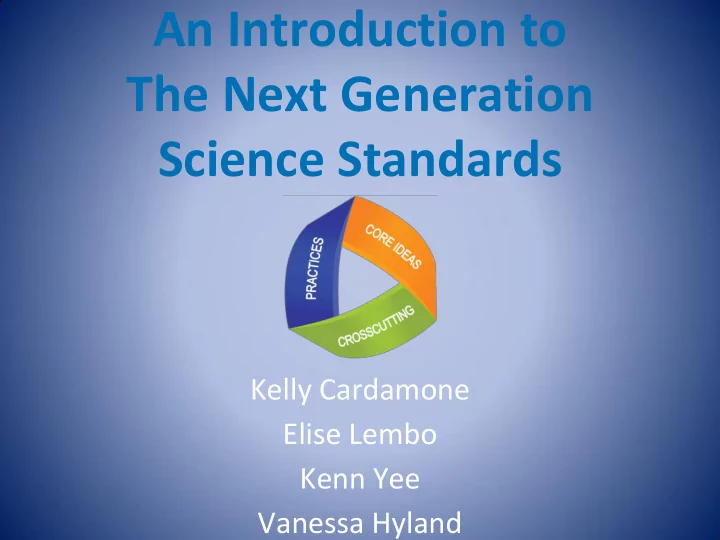

An Introduction to The Next Generation Science Standards Kelly Cardamone Elise Lembo Kenn Yee Vanessa Hyland
NGSS Curriculum Cohort • Began last December • Led by Jamie Saponaro - Cohort Consultant • Met once a month for 6 months • Included schools such as Avon, Bradley Beach, Sea Girt, SLH, and Farmingdale
Curriculum Cohort Objectives Phase I • Unpack Next Generations Science Standards with analysis of Disciplinary Core Ideas, Crosscutting Concepts, and Science and Engineering Practices • Create Shared Vision for students • Identify instructional shifts • Determine what effective assessment and successful implementation would look like (5Es) Phase II • Develop unit overviews by topic with guiding questions • Create assessments based on performance expectations • Determine the 3 dimensions to be the focus of the lesson • Develop lesson objective statements based on 3 dimensions • Coordinate resources, materials, and readings to support lessons Phase III • Reflect on process • Address any Performance Expectations that have not been addressed • Revise curriculum as necessary • Test out lessons in classes • Reflect and Report
Collaborate with Brielle Colleagues Scope and Sequence Unit and Lesson Plans 10 hours of Curriculum Writing over the STEM/STEAM Activities summer Common Assessments
5 E Inquiry Based Science Model
Conceptual Shifts in NGSS 1. K-12 science education should reflect the interconnected nature of science as it is practiced and experienced in the real world. 1. The NGSS are student performance expectations – NOT curriculum. 1. The science concepts build coherently from K-12. 1. The NGSS focus on deeper understanding of content as well as application of content. 1. Science and engineering are Integrated in the NGSS from K – 12. 1. The NGSS are designed to prepare students for college, career, and citizenship. 1. The NGSS and Common Core State Standards (Mathematics and English Language Arts) are aligned. 6
Three Important Shifts at Brielle 1. Three Dimensional Instruction 2. Performance Expectations as Assessment 3. Curriculum/Instructional Materials
A New Vision for Teaching and Learning Core ideas in Science and the discipline Engineering Concepts across disciplines
Dimension 1 Dimension 1 Scientific and Engineering Practices Science and Engineering Practices 5. Using mathematics and 1. Asking questions computational thinking (science) and defining problems (engineering) 6. Constructing explanations (science) 2. Developing and using and designing solutions models (engineering) 3. Planning and carrying 7. Engaging in argument out investigations from evidence 4. Analyzing and 8. Obtaining, evaluating, interpreting data and communicating information
Dimension 2 Crosscutting Concepts 1. Patterns 2. Cause & Effect 3. Scale, Proportion, & Quantity 4. Systems & System Models 5. Energy & Matter 6. Structure & Function 7. Stability & Change
Dimension 3- Disciplinary Core Ideas Disciplinary Significance • – Has broad importance across multiple science or engineering disciplines, a key organizing concept of a single discipline Explanatory Power • – Can be used to explain a host of phenomena Generative • – Provides a key tool for understanding or investigating more complex ideas and solving problems Relevant to People's Lives • – Relates to the interests and life experiences of students, connected to societal or personal concerns Usable from K to 12 • – Is teachable and learnable over multiple grades at increasing levels of depth and sophistication
4 Disciplinary Core Ideas Life Science (LS) Physical Science (PS) LS1: From Molecules to Organisms: PS1: Matter and Its Interactions Structures and Processes PS2: Motion and Stability: Forces and LS2: Ecosystems: Interactions, Energy, and Interactions Dynamics PS3: Energy LS3: Heredity: Inheritance and Variation of PS4: Waves and Their Applications in Traits Technologies for Information Transfer LS4: Biological Evolution: Unity and Diversity Earth & Space Science (ESS) Engineering & Technology (ETAS) ESS1: Earth’s Place in the Universe ETS1: Engineering Design ESS2: Earth’s Systems ETS2: Links Among Engineering, Technology, Science, and Society ESS3: Earth and Human Activity Integration from grades K - 8
Math Science M4. Models S1: Ask questions and define M1: Make sense of with mathematics problems problems S2: Develop & use models and persevere in solving them S3 : Plan & carry out investigations S5: Use mathematics & M2: Reason abstractly & S4: Analyze & interpret data computational thinking quantitatively S6: Construct explanations & E2: Build a strong base of knowledge M6: Attend to precision design solutions through content rich texts M7: Look for & make E5: Read, write, and speak use of structure grounded in evidence M8: Look for & E6: Use M3 & E4: Construct viable make use of technology S8: arguments and critique regularity & digital media Obtain, reasoning of others in repeated strategically & S7: Engage in reasoning capably evaluate, & argument from M5: Use appropriate evidence communicate tools strategically information E3: Obtain, synthesize, E1: Demonstrate independence in reading complex and report findings texts, and writing and speaking about them clearly Commonalities E7: Come to understand other perspectives and effectively in response Among the Practices and cultures through reading, listening, to task and purpose and collaborations in Science, Mathematics ELA and English Language Arts
Building on the Past; Preparing for the Future
If at first you don’t succeed , try, try again!! Click picture to watch video
Recommend
More recommend